Trauma Care Patient | Case Study | Nursing
VerifiedAdded on 2022/09/18
|13
|3702
|27
AI Summary
Contribute Materials
Your contribution can guide someone’s learning journey. Share your
documents today.
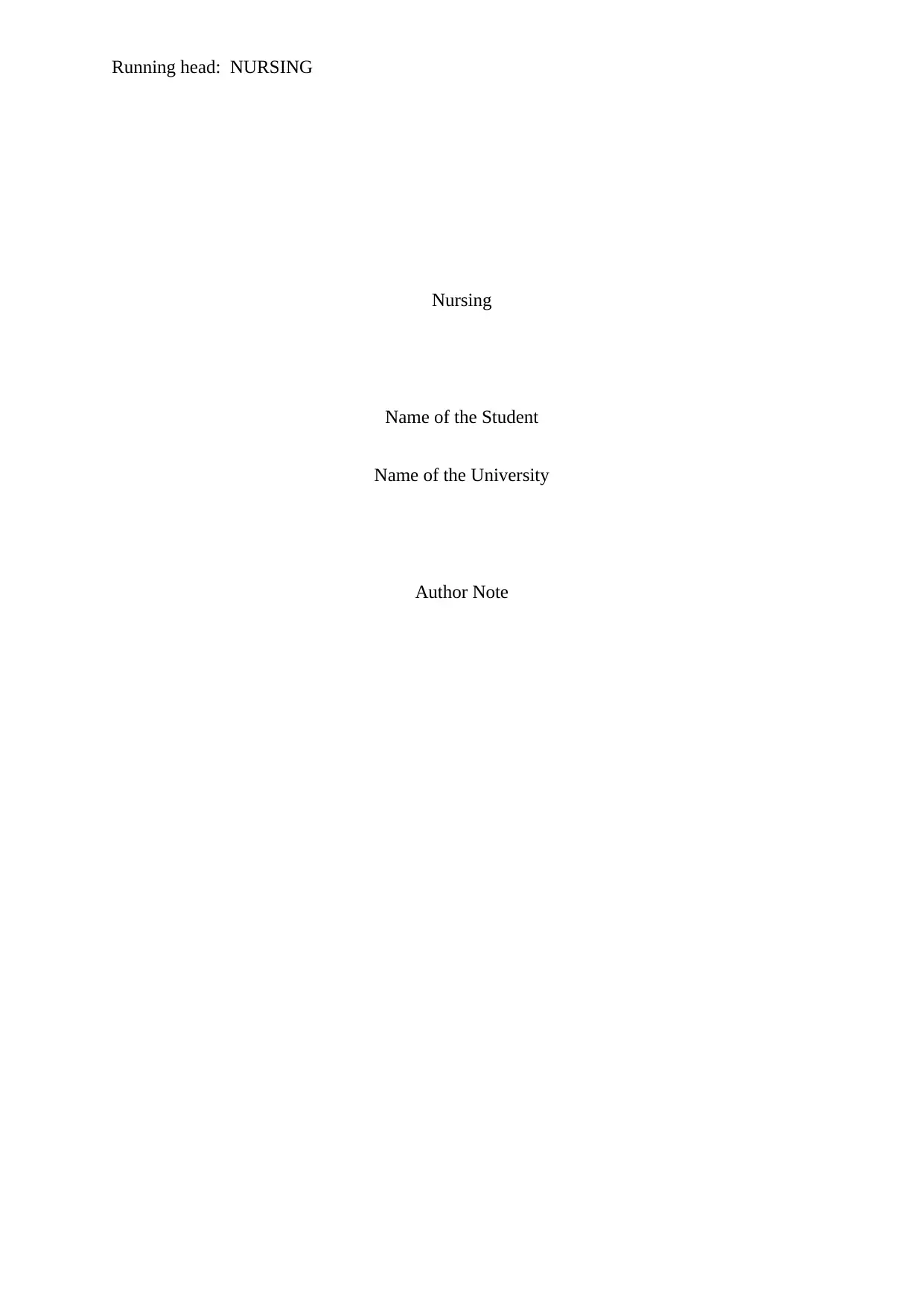
Running head: NURSING
Nursing
Name of the Student
Name of the University
Author Note
Nursing
Name of the Student
Name of the University
Author Note
Secure Best Marks with AI Grader
Need help grading? Try our AI Grader for instant feedback on your assignments.
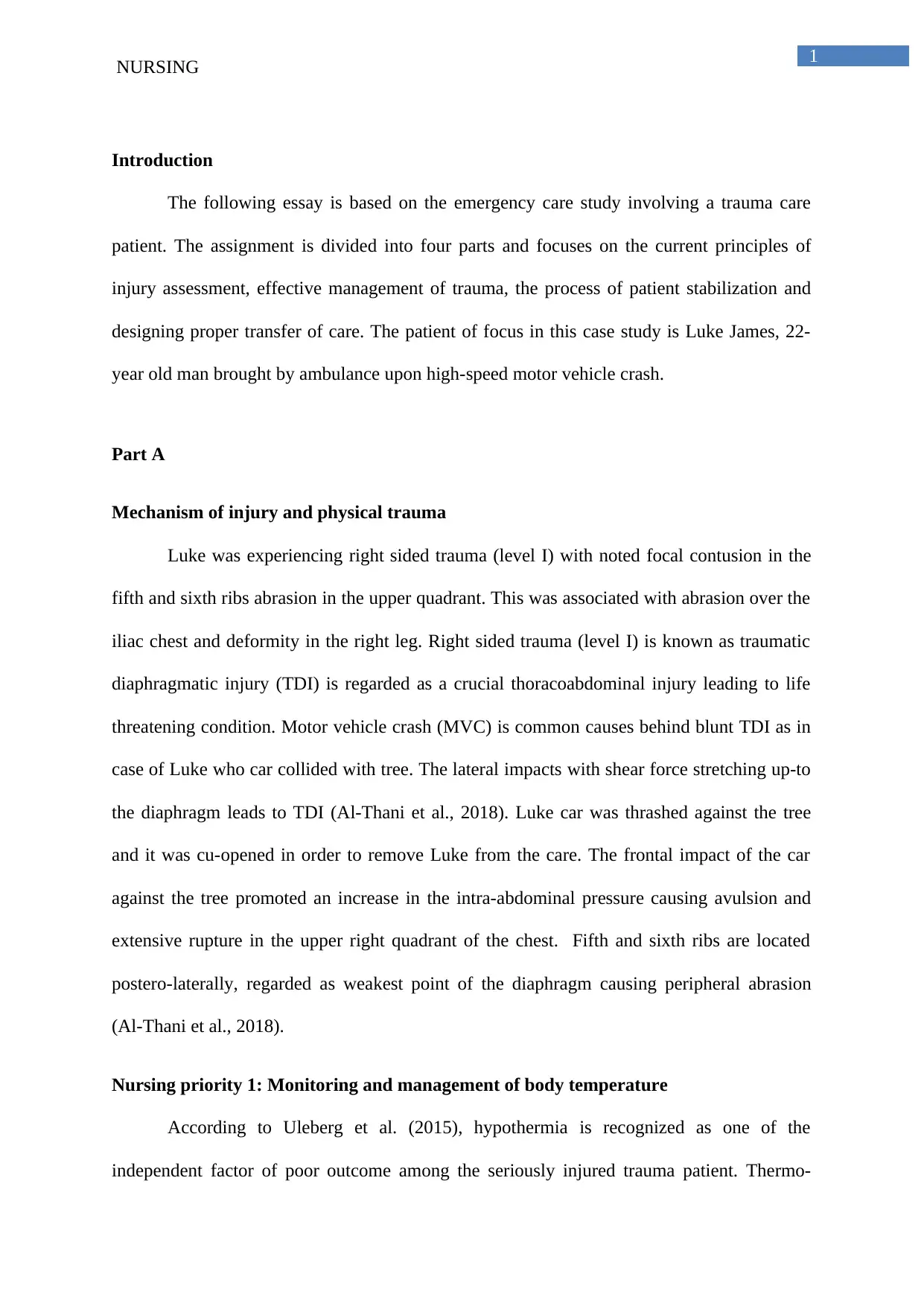
1
NURSING
Introduction
The following essay is based on the emergency care study involving a trauma care
patient. The assignment is divided into four parts and focuses on the current principles of
injury assessment, effective management of trauma, the process of patient stabilization and
designing proper transfer of care. The patient of focus in this case study is Luke James, 22-
year old man brought by ambulance upon high-speed motor vehicle crash.
Part A
Mechanism of injury and physical trauma
Luke was experiencing right sided trauma (level I) with noted focal contusion in the
fifth and sixth ribs abrasion in the upper quadrant. This was associated with abrasion over the
iliac chest and deformity in the right leg. Right sided trauma (level I) is known as traumatic
diaphragmatic injury (TDI) is regarded as a crucial thoracoabdominal injury leading to life
threatening condition. Motor vehicle crash (MVC) is common causes behind blunt TDI as in
case of Luke who car collided with tree. The lateral impacts with shear force stretching up-to
the diaphragm leads to TDI (Al-Thani et al., 2018). Luke car was thrashed against the tree
and it was cu-opened in order to remove Luke from the care. The frontal impact of the car
against the tree promoted an increase in the intra-abdominal pressure causing avulsion and
extensive rupture in the upper right quadrant of the chest. Fifth and sixth ribs are located
postero-laterally, regarded as weakest point of the diaphragm causing peripheral abrasion
(Al-Thani et al., 2018).
Nursing priority 1: Monitoring and management of body temperature
According to Uleberg et al. (2015), hypothermia is recognized as one of the
independent factor of poor outcome among the seriously injured trauma patient. Thermo-
NURSING
Introduction
The following essay is based on the emergency care study involving a trauma care
patient. The assignment is divided into four parts and focuses on the current principles of
injury assessment, effective management of trauma, the process of patient stabilization and
designing proper transfer of care. The patient of focus in this case study is Luke James, 22-
year old man brought by ambulance upon high-speed motor vehicle crash.
Part A
Mechanism of injury and physical trauma
Luke was experiencing right sided trauma (level I) with noted focal contusion in the
fifth and sixth ribs abrasion in the upper quadrant. This was associated with abrasion over the
iliac chest and deformity in the right leg. Right sided trauma (level I) is known as traumatic
diaphragmatic injury (TDI) is regarded as a crucial thoracoabdominal injury leading to life
threatening condition. Motor vehicle crash (MVC) is common causes behind blunt TDI as in
case of Luke who car collided with tree. The lateral impacts with shear force stretching up-to
the diaphragm leads to TDI (Al-Thani et al., 2018). Luke car was thrashed against the tree
and it was cu-opened in order to remove Luke from the care. The frontal impact of the car
against the tree promoted an increase in the intra-abdominal pressure causing avulsion and
extensive rupture in the upper right quadrant of the chest. Fifth and sixth ribs are located
postero-laterally, regarded as weakest point of the diaphragm causing peripheral abrasion
(Al-Thani et al., 2018).
Nursing priority 1: Monitoring and management of body temperature
According to Uleberg et al. (2015), hypothermia is recognized as one of the
independent factor of poor outcome among the seriously injured trauma patient. Thermo-
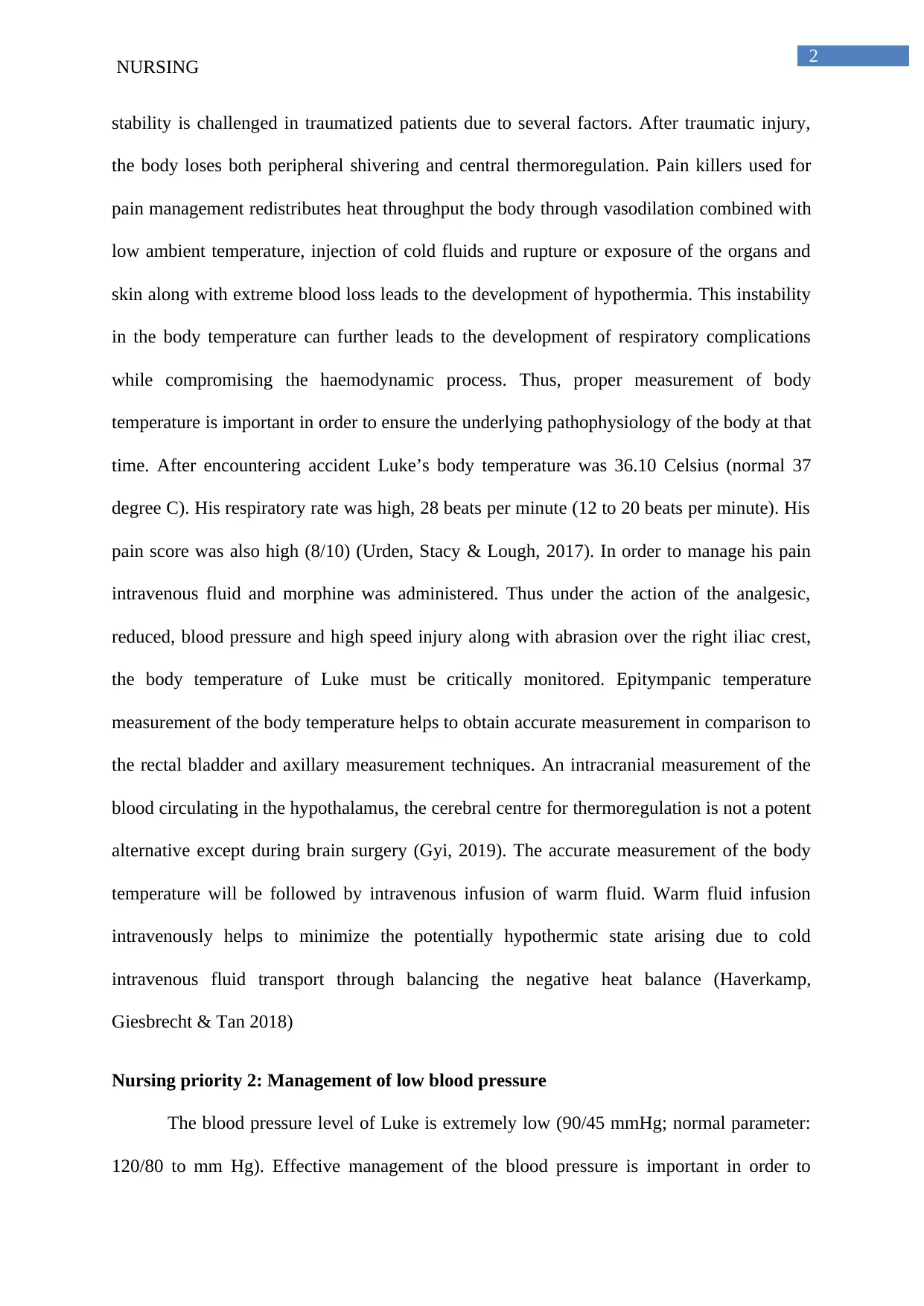
2
NURSING
stability is challenged in traumatized patients due to several factors. After traumatic injury,
the body loses both peripheral shivering and central thermoregulation. Pain killers used for
pain management redistributes heat throughput the body through vasodilation combined with
low ambient temperature, injection of cold fluids and rupture or exposure of the organs and
skin along with extreme blood loss leads to the development of hypothermia. This instability
in the body temperature can further leads to the development of respiratory complications
while compromising the haemodynamic process. Thus, proper measurement of body
temperature is important in order to ensure the underlying pathophysiology of the body at that
time. After encountering accident Luke’s body temperature was 36.10 Celsius (normal 37
degree C). His respiratory rate was high, 28 beats per minute (12 to 20 beats per minute). His
pain score was also high (8/10) (Urden, Stacy & Lough, 2017). In order to manage his pain
intravenous fluid and morphine was administered. Thus under the action of the analgesic,
reduced, blood pressure and high speed injury along with abrasion over the right iliac crest,
the body temperature of Luke must be critically monitored. Epitympanic temperature
measurement of the body temperature helps to obtain accurate measurement in comparison to
the rectal bladder and axillary measurement techniques. An intracranial measurement of the
blood circulating in the hypothalamus, the cerebral centre for thermoregulation is not a potent
alternative except during brain surgery (Gyi, 2019). The accurate measurement of the body
temperature will be followed by intravenous infusion of warm fluid. Warm fluid infusion
intravenously helps to minimize the potentially hypothermic state arising due to cold
intravenous fluid transport through balancing the negative heat balance (Haverkamp,
Giesbrecht & Tan 2018)
Nursing priority 2: Management of low blood pressure
The blood pressure level of Luke is extremely low (90/45 mmHg; normal parameter:
120/80 to mm Hg). Effective management of the blood pressure is important in order to
NURSING
stability is challenged in traumatized patients due to several factors. After traumatic injury,
the body loses both peripheral shivering and central thermoregulation. Pain killers used for
pain management redistributes heat throughput the body through vasodilation combined with
low ambient temperature, injection of cold fluids and rupture or exposure of the organs and
skin along with extreme blood loss leads to the development of hypothermia. This instability
in the body temperature can further leads to the development of respiratory complications
while compromising the haemodynamic process. Thus, proper measurement of body
temperature is important in order to ensure the underlying pathophysiology of the body at that
time. After encountering accident Luke’s body temperature was 36.10 Celsius (normal 37
degree C). His respiratory rate was high, 28 beats per minute (12 to 20 beats per minute). His
pain score was also high (8/10) (Urden, Stacy & Lough, 2017). In order to manage his pain
intravenous fluid and morphine was administered. Thus under the action of the analgesic,
reduced, blood pressure and high speed injury along with abrasion over the right iliac crest,
the body temperature of Luke must be critically monitored. Epitympanic temperature
measurement of the body temperature helps to obtain accurate measurement in comparison to
the rectal bladder and axillary measurement techniques. An intracranial measurement of the
blood circulating in the hypothalamus, the cerebral centre for thermoregulation is not a potent
alternative except during brain surgery (Gyi, 2019). The accurate measurement of the body
temperature will be followed by intravenous infusion of warm fluid. Warm fluid infusion
intravenously helps to minimize the potentially hypothermic state arising due to cold
intravenous fluid transport through balancing the negative heat balance (Haverkamp,
Giesbrecht & Tan 2018)
Nursing priority 2: Management of low blood pressure
The blood pressure level of Luke is extremely low (90/45 mmHg; normal parameter:
120/80 to mm Hg). Effective management of the blood pressure is important in order to
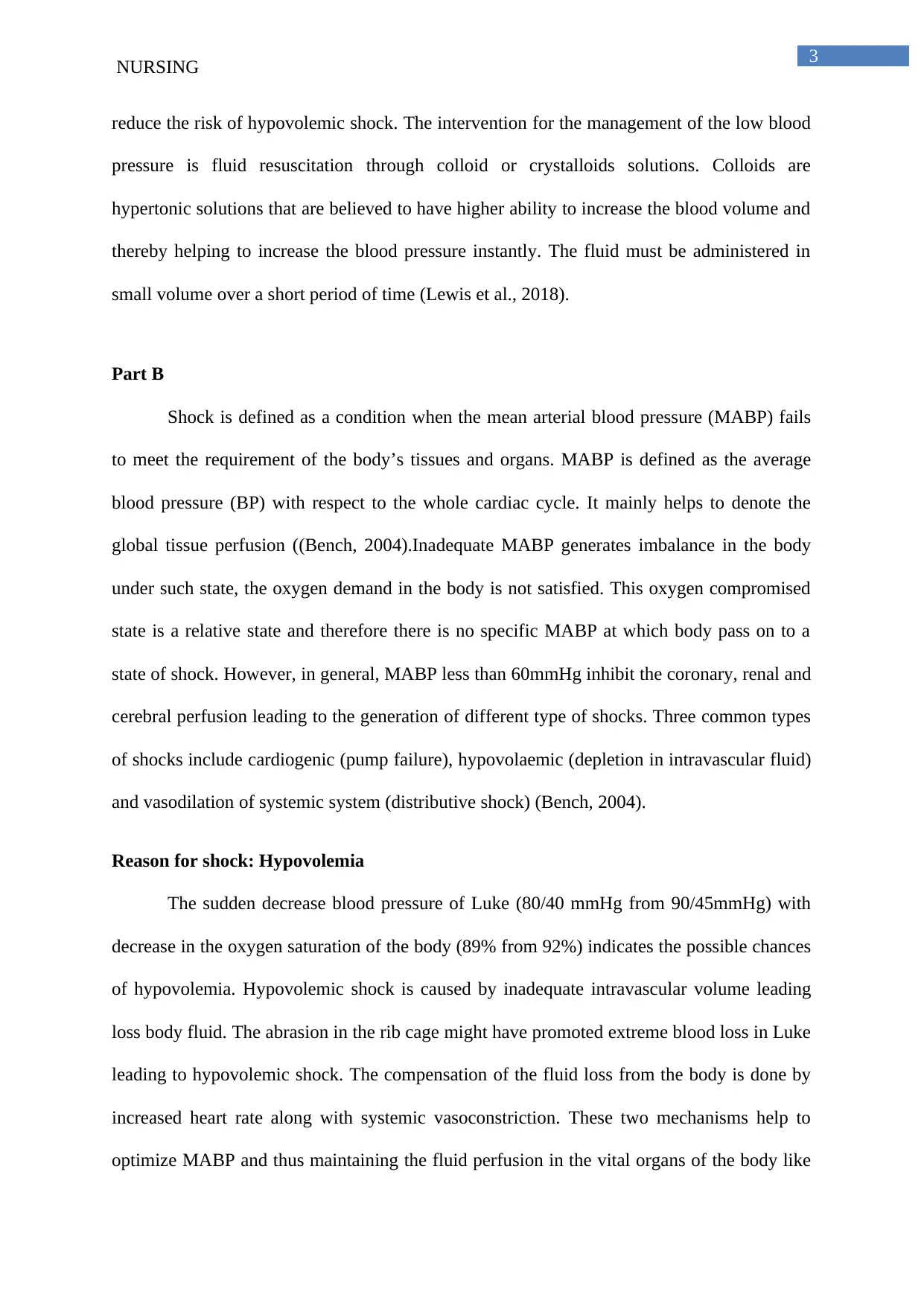
3
NURSING
reduce the risk of hypovolemic shock. The intervention for the management of the low blood
pressure is fluid resuscitation through colloid or crystalloids solutions. Colloids are
hypertonic solutions that are believed to have higher ability to increase the blood volume and
thereby helping to increase the blood pressure instantly. The fluid must be administered in
small volume over a short period of time (Lewis et al., 2018).
Part B
Shock is defined as a condition when the mean arterial blood pressure (MABP) fails
to meet the requirement of the body’s tissues and organs. MABP is defined as the average
blood pressure (BP) with respect to the whole cardiac cycle. It mainly helps to denote the
global tissue perfusion ((Bench, 2004).Inadequate MABP generates imbalance in the body
under such state, the oxygen demand in the body is not satisfied. This oxygen compromised
state is a relative state and therefore there is no specific MABP at which body pass on to a
state of shock. However, in general, MABP less than 60mmHg inhibit the coronary, renal and
cerebral perfusion leading to the generation of different type of shocks. Three common types
of shocks include cardiogenic (pump failure), hypovolaemic (depletion in intravascular fluid)
and vasodilation of systemic system (distributive shock) (Bench, 2004).
Reason for shock: Hypovolemia
The sudden decrease blood pressure of Luke (80/40 mmHg from 90/45mmHg) with
decrease in the oxygen saturation of the body (89% from 92%) indicates the possible chances
of hypovolemia. Hypovolemic shock is caused by inadequate intravascular volume leading
loss body fluid. The abrasion in the rib cage might have promoted extreme blood loss in Luke
leading to hypovolemic shock. The compensation of the fluid loss from the body is done by
increased heart rate along with systemic vasoconstriction. These two mechanisms help to
optimize MABP and thus maintaining the fluid perfusion in the vital organs of the body like
NURSING
reduce the risk of hypovolemic shock. The intervention for the management of the low blood
pressure is fluid resuscitation through colloid or crystalloids solutions. Colloids are
hypertonic solutions that are believed to have higher ability to increase the blood volume and
thereby helping to increase the blood pressure instantly. The fluid must be administered in
small volume over a short period of time (Lewis et al., 2018).
Part B
Shock is defined as a condition when the mean arterial blood pressure (MABP) fails
to meet the requirement of the body’s tissues and organs. MABP is defined as the average
blood pressure (BP) with respect to the whole cardiac cycle. It mainly helps to denote the
global tissue perfusion ((Bench, 2004).Inadequate MABP generates imbalance in the body
under such state, the oxygen demand in the body is not satisfied. This oxygen compromised
state is a relative state and therefore there is no specific MABP at which body pass on to a
state of shock. However, in general, MABP less than 60mmHg inhibit the coronary, renal and
cerebral perfusion leading to the generation of different type of shocks. Three common types
of shocks include cardiogenic (pump failure), hypovolaemic (depletion in intravascular fluid)
and vasodilation of systemic system (distributive shock) (Bench, 2004).
Reason for shock: Hypovolemia
The sudden decrease blood pressure of Luke (80/40 mmHg from 90/45mmHg) with
decrease in the oxygen saturation of the body (89% from 92%) indicates the possible chances
of hypovolemia. Hypovolemic shock is caused by inadequate intravascular volume leading
loss body fluid. The abrasion in the rib cage might have promoted extreme blood loss in Luke
leading to hypovolemic shock. The compensation of the fluid loss from the body is done by
increased heart rate along with systemic vasoconstriction. These two mechanisms help to
optimize MABP and thus maintaining the fluid perfusion in the vital organs of the body like
Secure Best Marks with AI Grader
Need help grading? Try our AI Grader for instant feedback on your assignments.
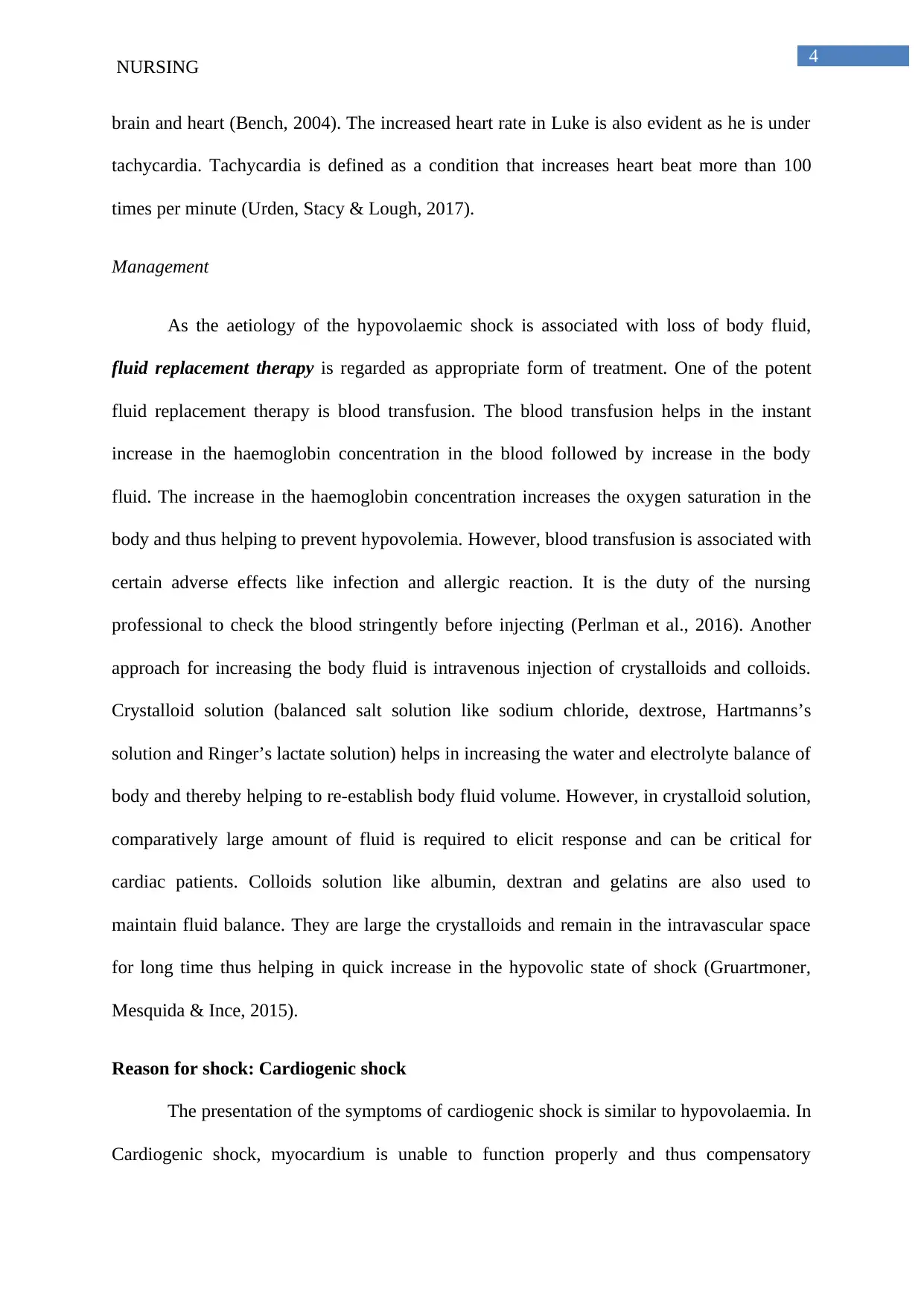
4
NURSING
brain and heart (Bench, 2004). The increased heart rate in Luke is also evident as he is under
tachycardia. Tachycardia is defined as a condition that increases heart beat more than 100
times per minute (Urden, Stacy & Lough, 2017).
Management
As the aetiology of the hypovolaemic shock is associated with loss of body fluid,
fluid replacement therapy is regarded as appropriate form of treatment. One of the potent
fluid replacement therapy is blood transfusion. The blood transfusion helps in the instant
increase in the haemoglobin concentration in the blood followed by increase in the body
fluid. The increase in the haemoglobin concentration increases the oxygen saturation in the
body and thus helping to prevent hypovolemia. However, blood transfusion is associated with
certain adverse effects like infection and allergic reaction. It is the duty of the nursing
professional to check the blood stringently before injecting (Perlman et al., 2016). Another
approach for increasing the body fluid is intravenous injection of crystalloids and colloids.
Crystalloid solution (balanced salt solution like sodium chloride, dextrose, Hartmanns’s
solution and Ringer’s lactate solution) helps in increasing the water and electrolyte balance of
body and thereby helping to re-establish body fluid volume. However, in crystalloid solution,
comparatively large amount of fluid is required to elicit response and can be critical for
cardiac patients. Colloids solution like albumin, dextran and gelatins are also used to
maintain fluid balance. They are large the crystalloids and remain in the intravascular space
for long time thus helping in quick increase in the hypovolic state of shock (Gruartmoner,
Mesquida & Ince, 2015).
Reason for shock: Cardiogenic shock
The presentation of the symptoms of cardiogenic shock is similar to hypovolaemia. In
Cardiogenic shock, myocardium is unable to function properly and thus compensatory
NURSING
brain and heart (Bench, 2004). The increased heart rate in Luke is also evident as he is under
tachycardia. Tachycardia is defined as a condition that increases heart beat more than 100
times per minute (Urden, Stacy & Lough, 2017).
Management
As the aetiology of the hypovolaemic shock is associated with loss of body fluid,
fluid replacement therapy is regarded as appropriate form of treatment. One of the potent
fluid replacement therapy is blood transfusion. The blood transfusion helps in the instant
increase in the haemoglobin concentration in the blood followed by increase in the body
fluid. The increase in the haemoglobin concentration increases the oxygen saturation in the
body and thus helping to prevent hypovolemia. However, blood transfusion is associated with
certain adverse effects like infection and allergic reaction. It is the duty of the nursing
professional to check the blood stringently before injecting (Perlman et al., 2016). Another
approach for increasing the body fluid is intravenous injection of crystalloids and colloids.
Crystalloid solution (balanced salt solution like sodium chloride, dextrose, Hartmanns’s
solution and Ringer’s lactate solution) helps in increasing the water and electrolyte balance of
body and thereby helping to re-establish body fluid volume. However, in crystalloid solution,
comparatively large amount of fluid is required to elicit response and can be critical for
cardiac patients. Colloids solution like albumin, dextran and gelatins are also used to
maintain fluid balance. They are large the crystalloids and remain in the intravascular space
for long time thus helping in quick increase in the hypovolic state of shock (Gruartmoner,
Mesquida & Ince, 2015).
Reason for shock: Cardiogenic shock
The presentation of the symptoms of cardiogenic shock is similar to hypovolaemia. In
Cardiogenic shock, myocardium is unable to function properly and thus compensatory
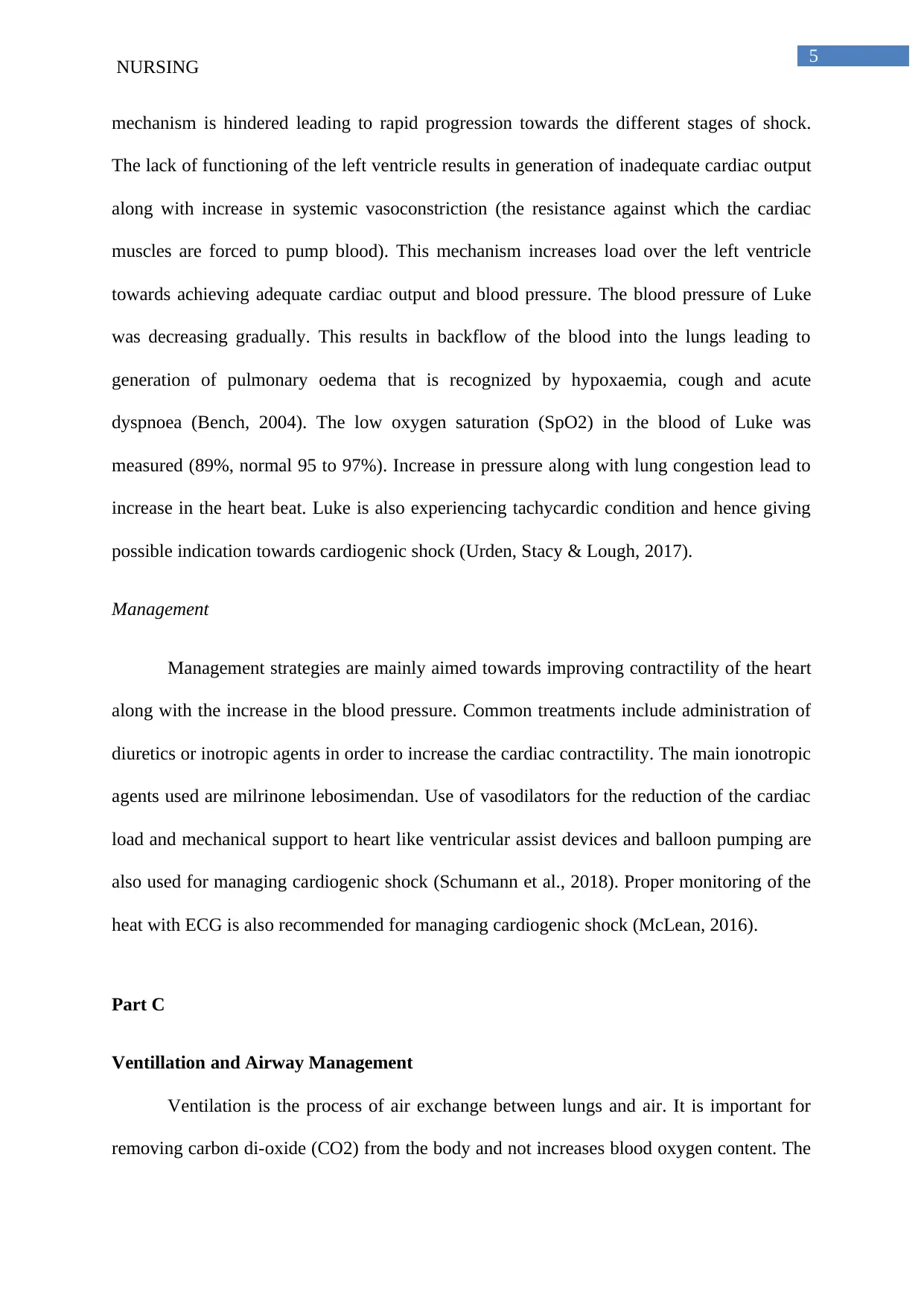
5
NURSING
mechanism is hindered leading to rapid progression towards the different stages of shock.
The lack of functioning of the left ventricle results in generation of inadequate cardiac output
along with increase in systemic vasoconstriction (the resistance against which the cardiac
muscles are forced to pump blood). This mechanism increases load over the left ventricle
towards achieving adequate cardiac output and blood pressure. The blood pressure of Luke
was decreasing gradually. This results in backflow of the blood into the lungs leading to
generation of pulmonary oedema that is recognized by hypoxaemia, cough and acute
dyspnoea (Bench, 2004). The low oxygen saturation (SpO2) in the blood of Luke was
measured (89%, normal 95 to 97%). Increase in pressure along with lung congestion lead to
increase in the heart beat. Luke is also experiencing tachycardic condition and hence giving
possible indication towards cardiogenic shock (Urden, Stacy & Lough, 2017).
Management
Management strategies are mainly aimed towards improving contractility of the heart
along with the increase in the blood pressure. Common treatments include administration of
diuretics or inotropic agents in order to increase the cardiac contractility. The main ionotropic
agents used are milrinone lebosimendan. Use of vasodilators for the reduction of the cardiac
load and mechanical support to heart like ventricular assist devices and balloon pumping are
also used for managing cardiogenic shock (Schumann et al., 2018). Proper monitoring of the
heat with ECG is also recommended for managing cardiogenic shock (McLean, 2016).
Part C
Ventillation and Airway Management
Ventilation is the process of air exchange between lungs and air. It is important for
removing carbon di-oxide (CO2) from the body and not increases blood oxygen content. The
NURSING
mechanism is hindered leading to rapid progression towards the different stages of shock.
The lack of functioning of the left ventricle results in generation of inadequate cardiac output
along with increase in systemic vasoconstriction (the resistance against which the cardiac
muscles are forced to pump blood). This mechanism increases load over the left ventricle
towards achieving adequate cardiac output and blood pressure. The blood pressure of Luke
was decreasing gradually. This results in backflow of the blood into the lungs leading to
generation of pulmonary oedema that is recognized by hypoxaemia, cough and acute
dyspnoea (Bench, 2004). The low oxygen saturation (SpO2) in the blood of Luke was
measured (89%, normal 95 to 97%). Increase in pressure along with lung congestion lead to
increase in the heart beat. Luke is also experiencing tachycardic condition and hence giving
possible indication towards cardiogenic shock (Urden, Stacy & Lough, 2017).
Management
Management strategies are mainly aimed towards improving contractility of the heart
along with the increase in the blood pressure. Common treatments include administration of
diuretics or inotropic agents in order to increase the cardiac contractility. The main ionotropic
agents used are milrinone lebosimendan. Use of vasodilators for the reduction of the cardiac
load and mechanical support to heart like ventricular assist devices and balloon pumping are
also used for managing cardiogenic shock (Schumann et al., 2018). Proper monitoring of the
heat with ECG is also recommended for managing cardiogenic shock (McLean, 2016).
Part C
Ventillation and Airway Management
Ventilation is the process of air exchange between lungs and air. It is important for
removing carbon di-oxide (CO2) from the body and not increases blood oxygen content. The
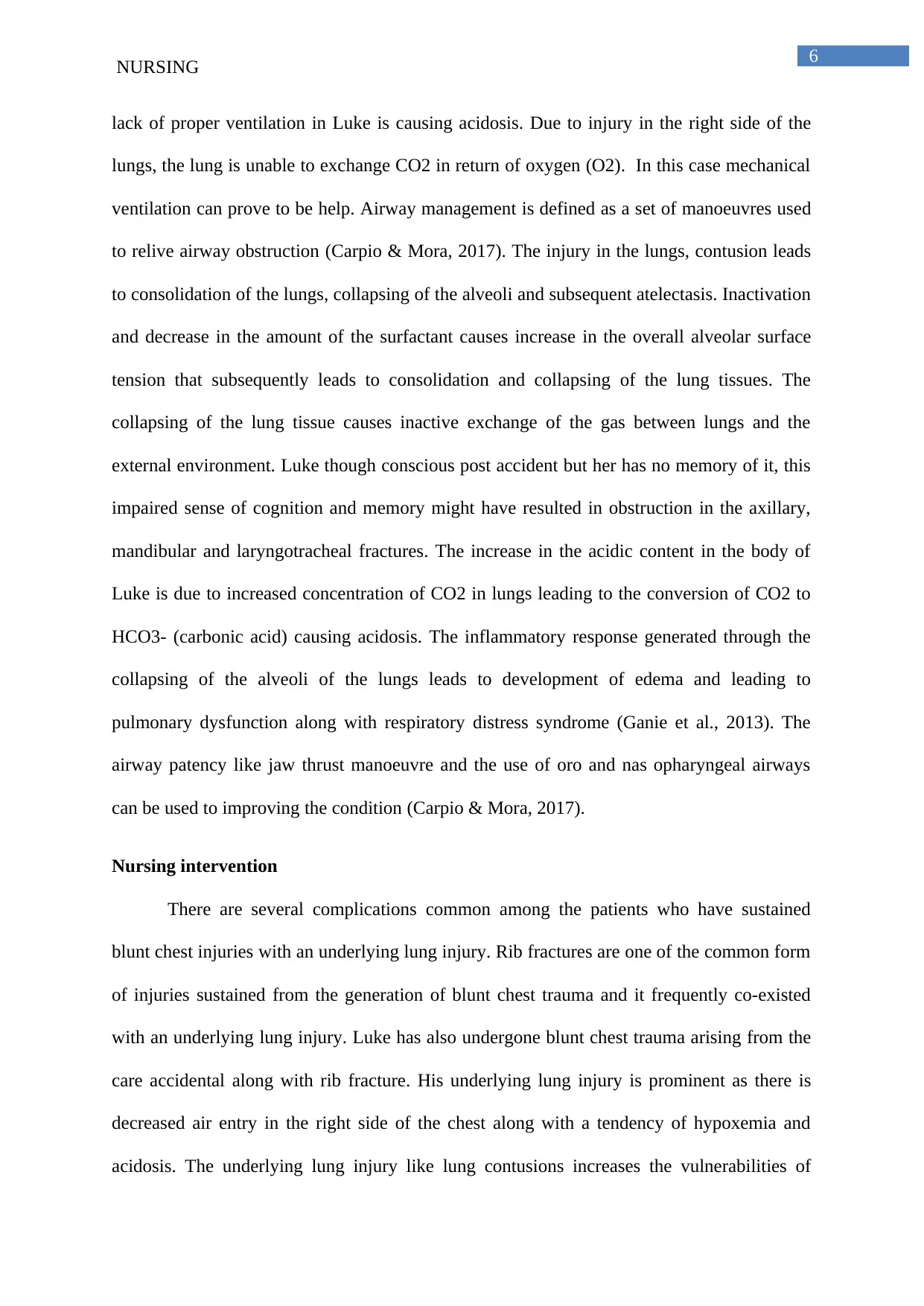
6
NURSING
lack of proper ventilation in Luke is causing acidosis. Due to injury in the right side of the
lungs, the lung is unable to exchange CO2 in return of oxygen (O2). In this case mechanical
ventilation can prove to be help. Airway management is defined as a set of manoeuvres used
to relive airway obstruction (Carpio & Mora, 2017). The injury in the lungs, contusion leads
to consolidation of the lungs, collapsing of the alveoli and subsequent atelectasis. Inactivation
and decrease in the amount of the surfactant causes increase in the overall alveolar surface
tension that subsequently leads to consolidation and collapsing of the lung tissues. The
collapsing of the lung tissue causes inactive exchange of the gas between lungs and the
external environment. Luke though conscious post accident but her has no memory of it, this
impaired sense of cognition and memory might have resulted in obstruction in the axillary,
mandibular and laryngotracheal fractures. The increase in the acidic content in the body of
Luke is due to increased concentration of CO2 in lungs leading to the conversion of CO2 to
HCO3- (carbonic acid) causing acidosis. The inflammatory response generated through the
collapsing of the alveoli of the lungs leads to development of edema and leading to
pulmonary dysfunction along with respiratory distress syndrome (Ganie et al., 2013). The
airway patency like jaw thrust manoeuvre and the use of oro and nas opharyngeal airways
can be used to improving the condition (Carpio & Mora, 2017).
Nursing intervention
There are several complications common among the patients who have sustained
blunt chest injuries with an underlying lung injury. Rib fractures are one of the common form
of injuries sustained from the generation of blunt chest trauma and it frequently co-existed
with an underlying lung injury. Luke has also undergone blunt chest trauma arising from the
care accidental along with rib fracture. His underlying lung injury is prominent as there is
decreased air entry in the right side of the chest along with a tendency of hypoxemia and
acidosis. The underlying lung injury like lung contusions increases the vulnerabilities of
NURSING
lack of proper ventilation in Luke is causing acidosis. Due to injury in the right side of the
lungs, the lung is unable to exchange CO2 in return of oxygen (O2). In this case mechanical
ventilation can prove to be help. Airway management is defined as a set of manoeuvres used
to relive airway obstruction (Carpio & Mora, 2017). The injury in the lungs, contusion leads
to consolidation of the lungs, collapsing of the alveoli and subsequent atelectasis. Inactivation
and decrease in the amount of the surfactant causes increase in the overall alveolar surface
tension that subsequently leads to consolidation and collapsing of the lung tissues. The
collapsing of the lung tissue causes inactive exchange of the gas between lungs and the
external environment. Luke though conscious post accident but her has no memory of it, this
impaired sense of cognition and memory might have resulted in obstruction in the axillary,
mandibular and laryngotracheal fractures. The increase in the acidic content in the body of
Luke is due to increased concentration of CO2 in lungs leading to the conversion of CO2 to
HCO3- (carbonic acid) causing acidosis. The inflammatory response generated through the
collapsing of the alveoli of the lungs leads to development of edema and leading to
pulmonary dysfunction along with respiratory distress syndrome (Ganie et al., 2013). The
airway patency like jaw thrust manoeuvre and the use of oro and nas opharyngeal airways
can be used to improving the condition (Carpio & Mora, 2017).
Nursing intervention
There are several complications common among the patients who have sustained
blunt chest injuries with an underlying lung injury. Rib fractures are one of the common form
of injuries sustained from the generation of blunt chest trauma and it frequently co-existed
with an underlying lung injury. Luke has also undergone blunt chest trauma arising from the
care accidental along with rib fracture. His underlying lung injury is prominent as there is
decreased air entry in the right side of the chest along with a tendency of hypoxemia and
acidosis. The underlying lung injury like lung contusions increases the vulnerabilities of
Paraphrase This Document
Need a fresh take? Get an instant paraphrase of this document with our AI Paraphraser
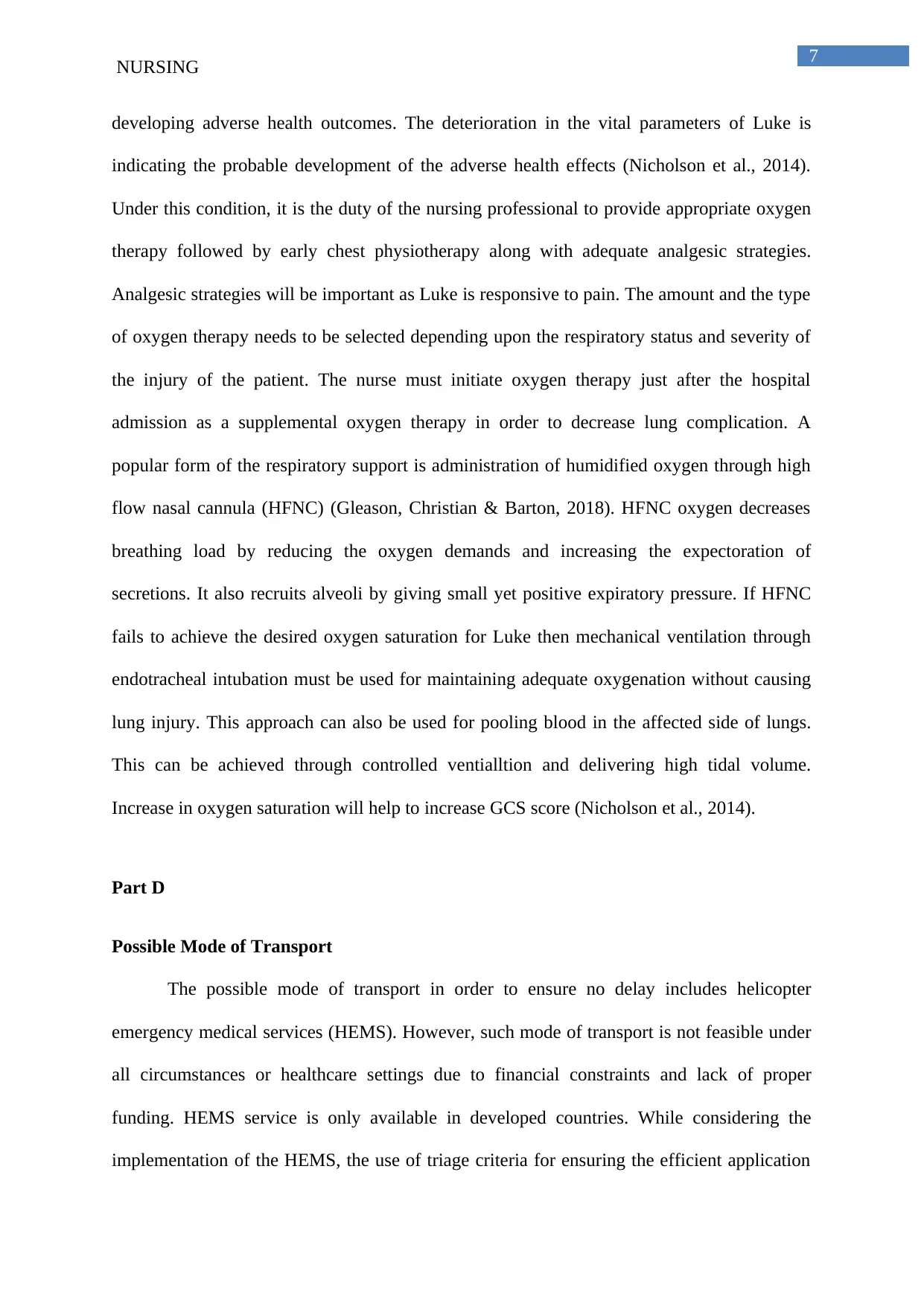
7
NURSING
developing adverse health outcomes. The deterioration in the vital parameters of Luke is
indicating the probable development of the adverse health effects (Nicholson et al., 2014).
Under this condition, it is the duty of the nursing professional to provide appropriate oxygen
therapy followed by early chest physiotherapy along with adequate analgesic strategies.
Analgesic strategies will be important as Luke is responsive to pain. The amount and the type
of oxygen therapy needs to be selected depending upon the respiratory status and severity of
the injury of the patient. The nurse must initiate oxygen therapy just after the hospital
admission as a supplemental oxygen therapy in order to decrease lung complication. A
popular form of the respiratory support is administration of humidified oxygen through high
flow nasal cannula (HFNC) (Gleason, Christian & Barton, 2018). HFNC oxygen decreases
breathing load by reducing the oxygen demands and increasing the expectoration of
secretions. It also recruits alveoli by giving small yet positive expiratory pressure. If HFNC
fails to achieve the desired oxygen saturation for Luke then mechanical ventilation through
endotracheal intubation must be used for maintaining adequate oxygenation without causing
lung injury. This approach can also be used for pooling blood in the affected side of lungs.
This can be achieved through controlled ventialltion and delivering high tidal volume.
Increase in oxygen saturation will help to increase GCS score (Nicholson et al., 2014).
Part D
Possible Mode of Transport
The possible mode of transport in order to ensure no delay includes helicopter
emergency medical services (HEMS). However, such mode of transport is not feasible under
all circumstances or healthcare settings due to financial constraints and lack of proper
funding. HEMS service is only available in developed countries. While considering the
implementation of the HEMS, the use of triage criteria for ensuring the efficient application
NURSING
developing adverse health outcomes. The deterioration in the vital parameters of Luke is
indicating the probable development of the adverse health effects (Nicholson et al., 2014).
Under this condition, it is the duty of the nursing professional to provide appropriate oxygen
therapy followed by early chest physiotherapy along with adequate analgesic strategies.
Analgesic strategies will be important as Luke is responsive to pain. The amount and the type
of oxygen therapy needs to be selected depending upon the respiratory status and severity of
the injury of the patient. The nurse must initiate oxygen therapy just after the hospital
admission as a supplemental oxygen therapy in order to decrease lung complication. A
popular form of the respiratory support is administration of humidified oxygen through high
flow nasal cannula (HFNC) (Gleason, Christian & Barton, 2018). HFNC oxygen decreases
breathing load by reducing the oxygen demands and increasing the expectoration of
secretions. It also recruits alveoli by giving small yet positive expiratory pressure. If HFNC
fails to achieve the desired oxygen saturation for Luke then mechanical ventilation through
endotracheal intubation must be used for maintaining adequate oxygenation without causing
lung injury. This approach can also be used for pooling blood in the affected side of lungs.
This can be achieved through controlled ventialltion and delivering high tidal volume.
Increase in oxygen saturation will help to increase GCS score (Nicholson et al., 2014).
Part D
Possible Mode of Transport
The possible mode of transport in order to ensure no delay includes helicopter
emergency medical services (HEMS). However, such mode of transport is not feasible under
all circumstances or healthcare settings due to financial constraints and lack of proper
funding. HEMS service is only available in developed countries. While considering the
implementation of the HEMS, the use of triage criteria for ensuring the efficient application
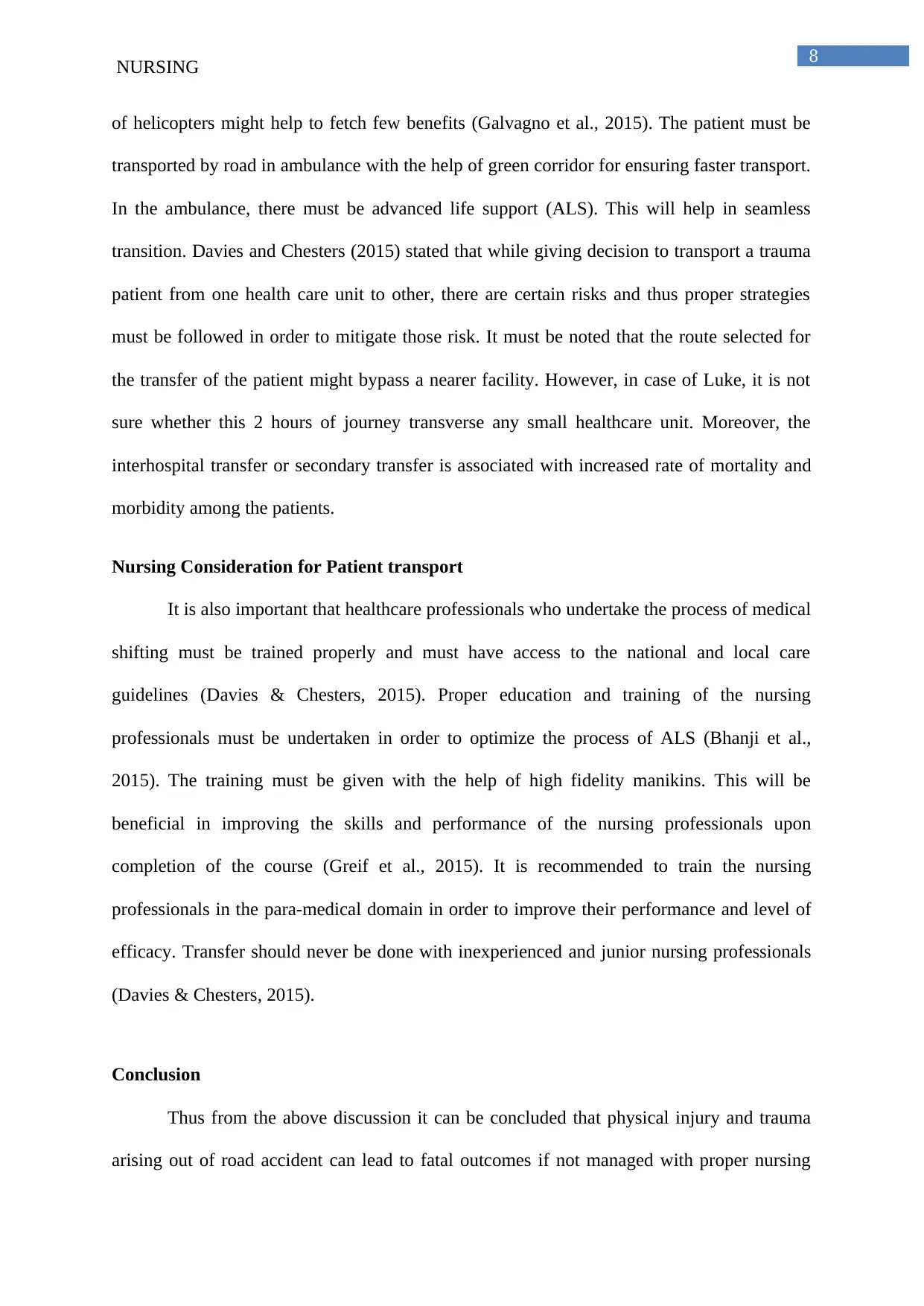
8
NURSING
of helicopters might help to fetch few benefits (Galvagno et al., 2015). The patient must be
transported by road in ambulance with the help of green corridor for ensuring faster transport.
In the ambulance, there must be advanced life support (ALS). This will help in seamless
transition. Davies and Chesters (2015) stated that while giving decision to transport a trauma
patient from one health care unit to other, there are certain risks and thus proper strategies
must be followed in order to mitigate those risk. It must be noted that the route selected for
the transfer of the patient might bypass a nearer facility. However, in case of Luke, it is not
sure whether this 2 hours of journey transverse any small healthcare unit. Moreover, the
interhospital transfer or secondary transfer is associated with increased rate of mortality and
morbidity among the patients.
Nursing Consideration for Patient transport
It is also important that healthcare professionals who undertake the process of medical
shifting must be trained properly and must have access to the national and local care
guidelines (Davies & Chesters, 2015). Proper education and training of the nursing
professionals must be undertaken in order to optimize the process of ALS (Bhanji et al.,
2015). The training must be given with the help of high fidelity manikins. This will be
beneficial in improving the skills and performance of the nursing professionals upon
completion of the course (Greif et al., 2015). It is recommended to train the nursing
professionals in the para-medical domain in order to improve their performance and level of
efficacy. Transfer should never be done with inexperienced and junior nursing professionals
(Davies & Chesters, 2015).
Conclusion
Thus from the above discussion it can be concluded that physical injury and trauma
arising out of road accident can lead to fatal outcomes if not managed with proper nursing
NURSING
of helicopters might help to fetch few benefits (Galvagno et al., 2015). The patient must be
transported by road in ambulance with the help of green corridor for ensuring faster transport.
In the ambulance, there must be advanced life support (ALS). This will help in seamless
transition. Davies and Chesters (2015) stated that while giving decision to transport a trauma
patient from one health care unit to other, there are certain risks and thus proper strategies
must be followed in order to mitigate those risk. It must be noted that the route selected for
the transfer of the patient might bypass a nearer facility. However, in case of Luke, it is not
sure whether this 2 hours of journey transverse any small healthcare unit. Moreover, the
interhospital transfer or secondary transfer is associated with increased rate of mortality and
morbidity among the patients.
Nursing Consideration for Patient transport
It is also important that healthcare professionals who undertake the process of medical
shifting must be trained properly and must have access to the national and local care
guidelines (Davies & Chesters, 2015). Proper education and training of the nursing
professionals must be undertaken in order to optimize the process of ALS (Bhanji et al.,
2015). The training must be given with the help of high fidelity manikins. This will be
beneficial in improving the skills and performance of the nursing professionals upon
completion of the course (Greif et al., 2015). It is recommended to train the nursing
professionals in the para-medical domain in order to improve their performance and level of
efficacy. Transfer should never be done with inexperienced and junior nursing professionals
(Davies & Chesters, 2015).
Conclusion
Thus from the above discussion it can be concluded that physical injury and trauma
arising out of road accident can lead to fatal outcomes if not managed with proper nursing
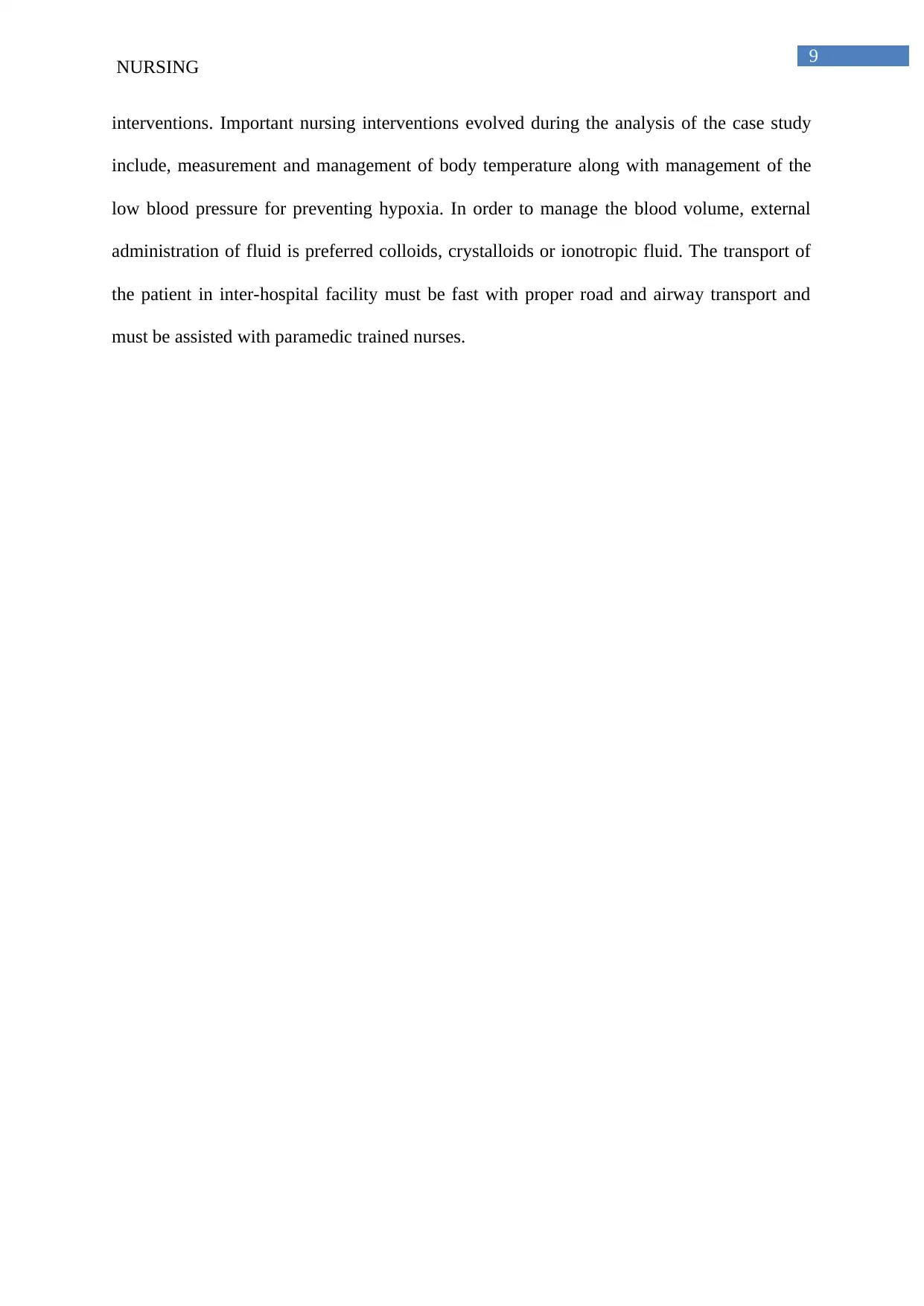
9
NURSING
interventions. Important nursing interventions evolved during the analysis of the case study
include, measurement and management of body temperature along with management of the
low blood pressure for preventing hypoxia. In order to manage the blood volume, external
administration of fluid is preferred colloids, crystalloids or ionotropic fluid. The transport of
the patient in inter-hospital facility must be fast with proper road and airway transport and
must be assisted with paramedic trained nurses.
NURSING
interventions. Important nursing interventions evolved during the analysis of the case study
include, measurement and management of body temperature along with management of the
low blood pressure for preventing hypoxia. In order to manage the blood volume, external
administration of fluid is preferred colloids, crystalloids or ionotropic fluid. The transport of
the patient in inter-hospital facility must be fast with proper road and airway transport and
must be assisted with paramedic trained nurses.
Secure Best Marks with AI Grader
Need help grading? Try our AI Grader for instant feedback on your assignments.
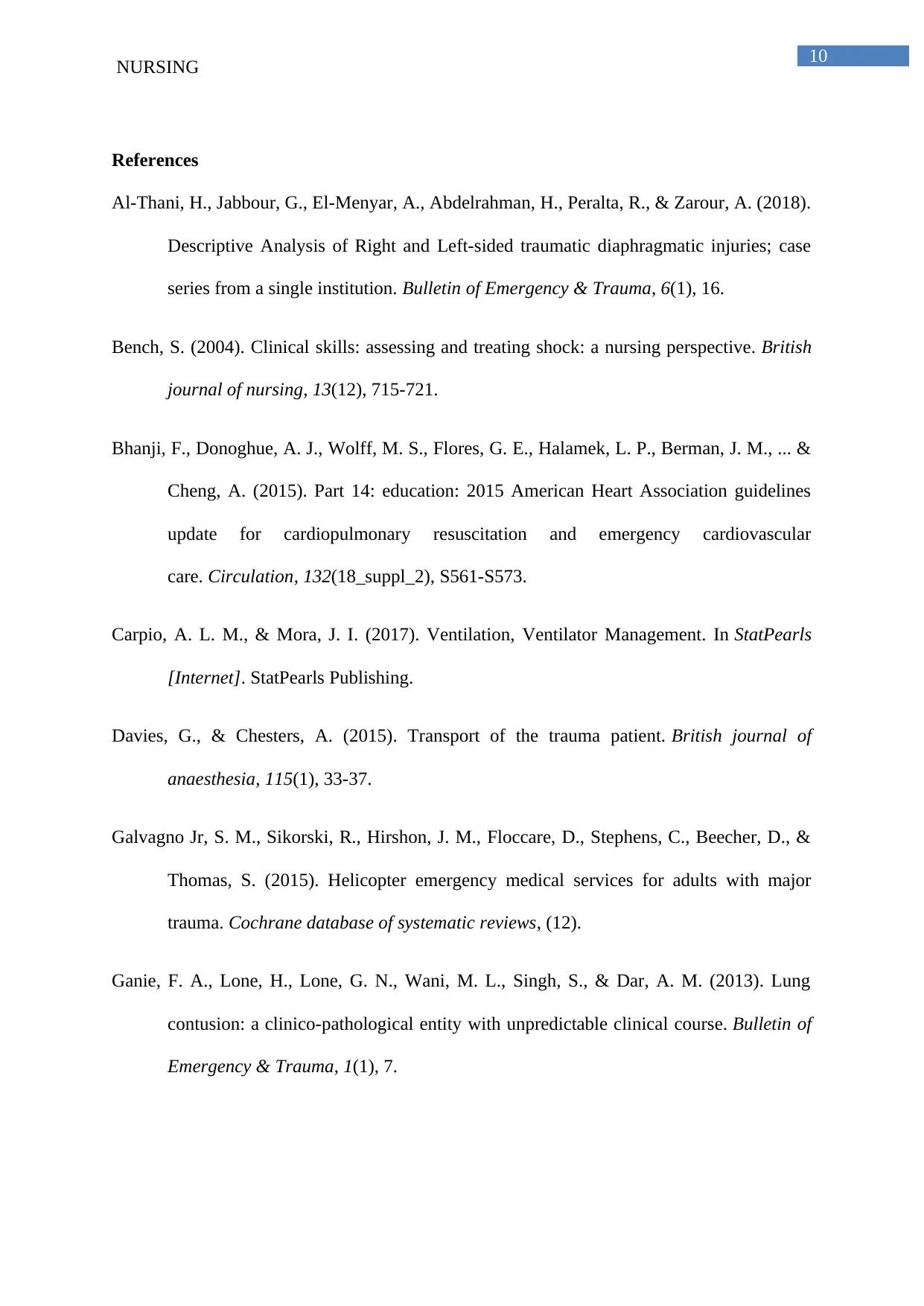
10
NURSING
References
Al-Thani, H., Jabbour, G., El-Menyar, A., Abdelrahman, H., Peralta, R., & Zarour, A. (2018).
Descriptive Analysis of Right and Left-sided traumatic diaphragmatic injuries; case
series from a single institution. Bulletin of Emergency & Trauma, 6(1), 16.
Bench, S. (2004). Clinical skills: assessing and treating shock: a nursing perspective. British
journal of nursing, 13(12), 715-721.
Bhanji, F., Donoghue, A. J., Wolff, M. S., Flores, G. E., Halamek, L. P., Berman, J. M., ... &
Cheng, A. (2015). Part 14: education: 2015 American Heart Association guidelines
update for cardiopulmonary resuscitation and emergency cardiovascular
care. Circulation, 132(18_suppl_2), S561-S573.
Carpio, A. L. M., & Mora, J. I. (2017). Ventilation, Ventilator Management. In StatPearls
[Internet]. StatPearls Publishing.
Davies, G., & Chesters, A. (2015). Transport of the trauma patient. British journal of
anaesthesia, 115(1), 33-37.
Galvagno Jr, S. M., Sikorski, R., Hirshon, J. M., Floccare, D., Stephens, C., Beecher, D., &
Thomas, S. (2015). Helicopter emergency medical services for adults with major
trauma. Cochrane database of systematic reviews, (12).
Ganie, F. A., Lone, H., Lone, G. N., Wani, M. L., Singh, S., & Dar, A. M. (2013). Lung
contusion: a clinico-pathological entity with unpredictable clinical course. Bulletin of
Emergency & Trauma, 1(1), 7.
NURSING
References
Al-Thani, H., Jabbour, G., El-Menyar, A., Abdelrahman, H., Peralta, R., & Zarour, A. (2018).
Descriptive Analysis of Right and Left-sided traumatic diaphragmatic injuries; case
series from a single institution. Bulletin of Emergency & Trauma, 6(1), 16.
Bench, S. (2004). Clinical skills: assessing and treating shock: a nursing perspective. British
journal of nursing, 13(12), 715-721.
Bhanji, F., Donoghue, A. J., Wolff, M. S., Flores, G. E., Halamek, L. P., Berman, J. M., ... &
Cheng, A. (2015). Part 14: education: 2015 American Heart Association guidelines
update for cardiopulmonary resuscitation and emergency cardiovascular
care. Circulation, 132(18_suppl_2), S561-S573.
Carpio, A. L. M., & Mora, J. I. (2017). Ventilation, Ventilator Management. In StatPearls
[Internet]. StatPearls Publishing.
Davies, G., & Chesters, A. (2015). Transport of the trauma patient. British journal of
anaesthesia, 115(1), 33-37.
Galvagno Jr, S. M., Sikorski, R., Hirshon, J. M., Floccare, D., Stephens, C., Beecher, D., &
Thomas, S. (2015). Helicopter emergency medical services for adults with major
trauma. Cochrane database of systematic reviews, (12).
Ganie, F. A., Lone, H., Lone, G. N., Wani, M. L., Singh, S., & Dar, A. M. (2013). Lung
contusion: a clinico-pathological entity with unpredictable clinical course. Bulletin of
Emergency & Trauma, 1(1), 7.
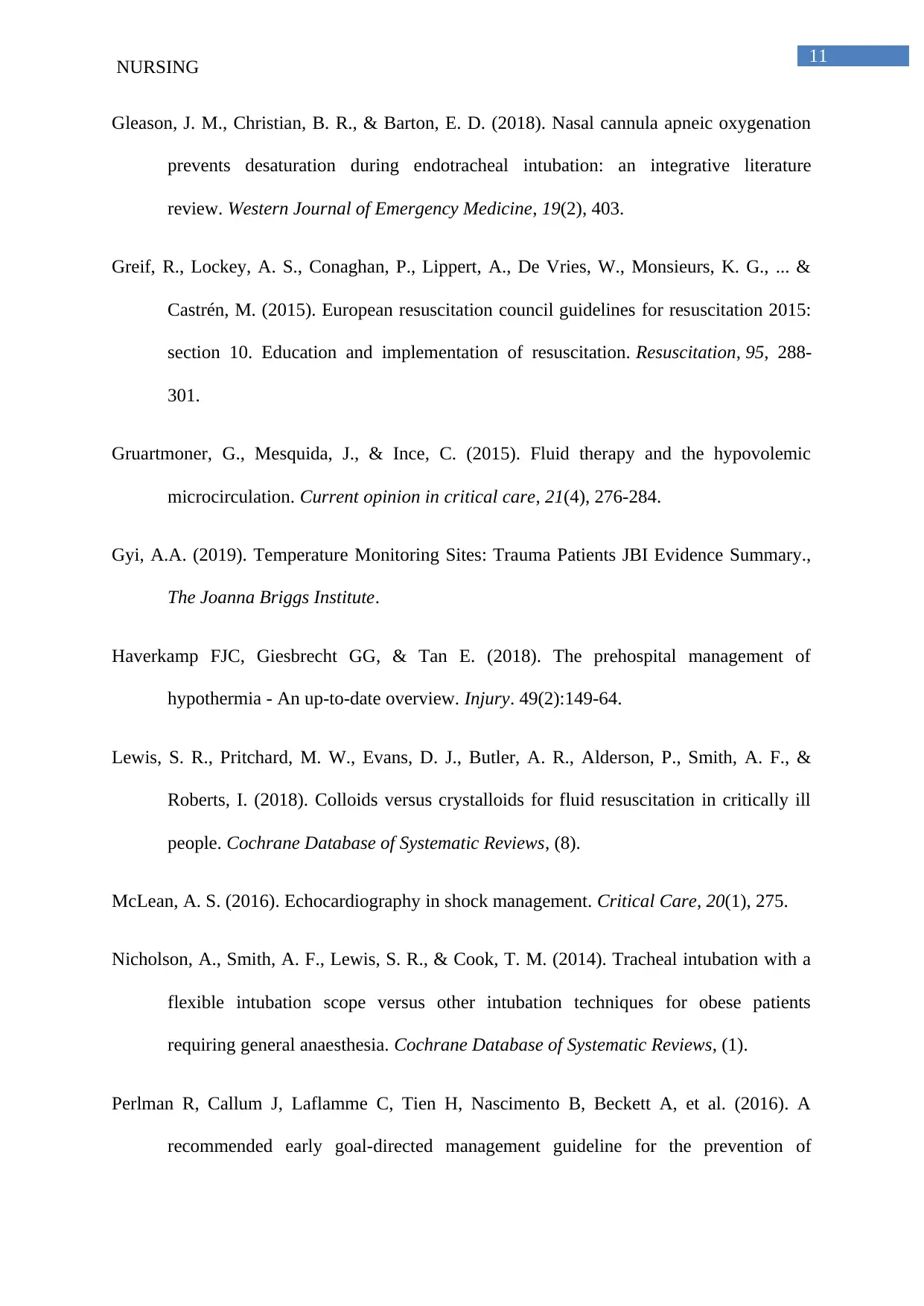
11
NURSING
Gleason, J. M., Christian, B. R., & Barton, E. D. (2018). Nasal cannula apneic oxygenation
prevents desaturation during endotracheal intubation: an integrative literature
review. Western Journal of Emergency Medicine, 19(2), 403.
Greif, R., Lockey, A. S., Conaghan, P., Lippert, A., De Vries, W., Monsieurs, K. G., ... &
Castrén, M. (2015). European resuscitation council guidelines for resuscitation 2015:
section 10. Education and implementation of resuscitation. Resuscitation, 95, 288-
301.
Gruartmoner, G., Mesquida, J., & Ince, C. (2015). Fluid therapy and the hypovolemic
microcirculation. Current opinion in critical care, 21(4), 276-284.
Gyi, A.A. (2019). Temperature Monitoring Sites: Trauma Patients JBI Evidence Summary.,
The Joanna Briggs Institute.
Haverkamp FJC, Giesbrecht GG, & Tan E. (2018). The prehospital management of
hypothermia - An up-to-date overview. Injury. 49(2):149-64.
Lewis, S. R., Pritchard, M. W., Evans, D. J., Butler, A. R., Alderson, P., Smith, A. F., &
Roberts, I. (2018). Colloids versus crystalloids for fluid resuscitation in critically ill
people. Cochrane Database of Systematic Reviews, (8).
McLean, A. S. (2016). Echocardiography in shock management. Critical Care, 20(1), 275.
Nicholson, A., Smith, A. F., Lewis, S. R., & Cook, T. M. (2014). Tracheal intubation with a
flexible intubation scope versus other intubation techniques for obese patients
requiring general anaesthesia. Cochrane Database of Systematic Reviews, (1).
Perlman R, Callum J, Laflamme C, Tien H, Nascimento B, Beckett A, et al. (2016). A
recommended early goal-directed management guideline for the prevention of
NURSING
Gleason, J. M., Christian, B. R., & Barton, E. D. (2018). Nasal cannula apneic oxygenation
prevents desaturation during endotracheal intubation: an integrative literature
review. Western Journal of Emergency Medicine, 19(2), 403.
Greif, R., Lockey, A. S., Conaghan, P., Lippert, A., De Vries, W., Monsieurs, K. G., ... &
Castrén, M. (2015). European resuscitation council guidelines for resuscitation 2015:
section 10. Education and implementation of resuscitation. Resuscitation, 95, 288-
301.
Gruartmoner, G., Mesquida, J., & Ince, C. (2015). Fluid therapy and the hypovolemic
microcirculation. Current opinion in critical care, 21(4), 276-284.
Gyi, A.A. (2019). Temperature Monitoring Sites: Trauma Patients JBI Evidence Summary.,
The Joanna Briggs Institute.
Haverkamp FJC, Giesbrecht GG, & Tan E. (2018). The prehospital management of
hypothermia - An up-to-date overview. Injury. 49(2):149-64.
Lewis, S. R., Pritchard, M. W., Evans, D. J., Butler, A. R., Alderson, P., Smith, A. F., &
Roberts, I. (2018). Colloids versus crystalloids for fluid resuscitation in critically ill
people. Cochrane Database of Systematic Reviews, (8).
McLean, A. S. (2016). Echocardiography in shock management. Critical Care, 20(1), 275.
Nicholson, A., Smith, A. F., Lewis, S. R., & Cook, T. M. (2014). Tracheal intubation with a
flexible intubation scope versus other intubation techniques for obese patients
requiring general anaesthesia. Cochrane Database of Systematic Reviews, (1).
Perlman R, Callum J, Laflamme C, Tien H, Nascimento B, Beckett A, et al. (2016). A
recommended early goal-directed management guideline for the prevention of
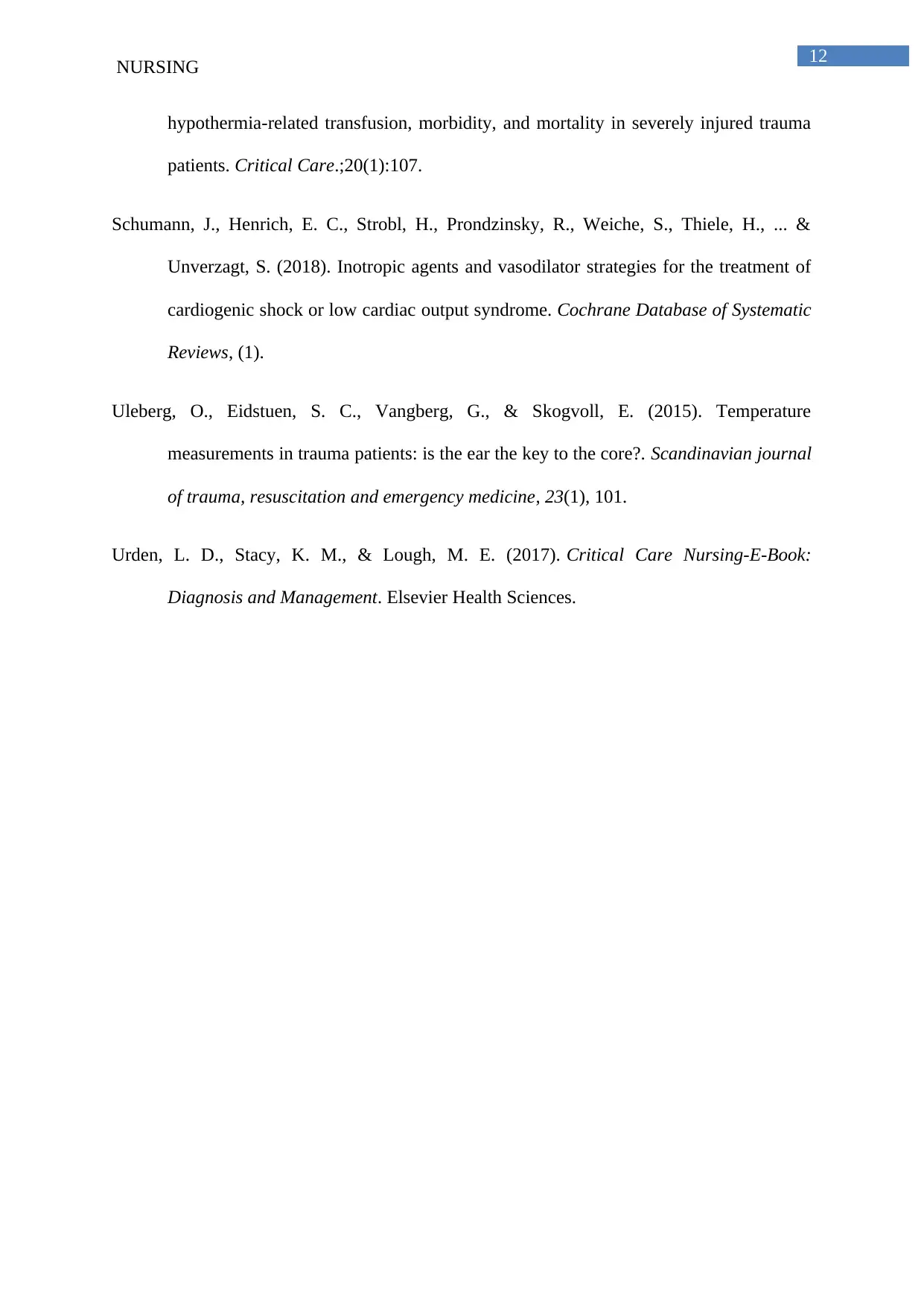
12
NURSING
hypothermia-related transfusion, morbidity, and mortality in severely injured trauma
patients. Critical Care.;20(1):107.
Schumann, J., Henrich, E. C., Strobl, H., Prondzinsky, R., Weiche, S., Thiele, H., ... &
Unverzagt, S. (2018). Inotropic agents and vasodilator strategies for the treatment of
cardiogenic shock or low cardiac output syndrome. Cochrane Database of Systematic
Reviews, (1).
Uleberg, O., Eidstuen, S. C., Vangberg, G., & Skogvoll, E. (2015). Temperature
measurements in trauma patients: is the ear the key to the core?. Scandinavian journal
of trauma, resuscitation and emergency medicine, 23(1), 101.
Urden, L. D., Stacy, K. M., & Lough, M. E. (2017). Critical Care Nursing-E-Book:
Diagnosis and Management. Elsevier Health Sciences.
NURSING
hypothermia-related transfusion, morbidity, and mortality in severely injured trauma
patients. Critical Care.;20(1):107.
Schumann, J., Henrich, E. C., Strobl, H., Prondzinsky, R., Weiche, S., Thiele, H., ... &
Unverzagt, S. (2018). Inotropic agents and vasodilator strategies for the treatment of
cardiogenic shock or low cardiac output syndrome. Cochrane Database of Systematic
Reviews, (1).
Uleberg, O., Eidstuen, S. C., Vangberg, G., & Skogvoll, E. (2015). Temperature
measurements in trauma patients: is the ear the key to the core?. Scandinavian journal
of trauma, resuscitation and emergency medicine, 23(1), 101.
Urden, L. D., Stacy, K. M., & Lough, M. E. (2017). Critical Care Nursing-E-Book:
Diagnosis and Management. Elsevier Health Sciences.
1 out of 13
Your All-in-One AI-Powered Toolkit for Academic Success.
+13062052269
info@desklib.com
Available 24*7 on WhatsApp / Email
![[object Object]](/_next/static/media/star-bottom.7253800d.svg)
Unlock your academic potential
© 2024 | Zucol Services PVT LTD | All rights reserved.